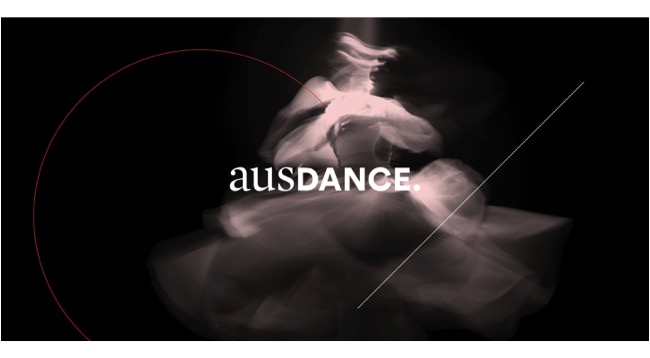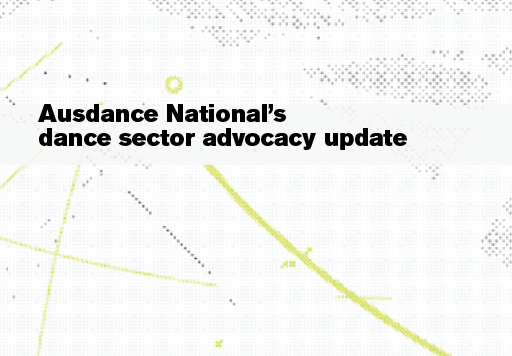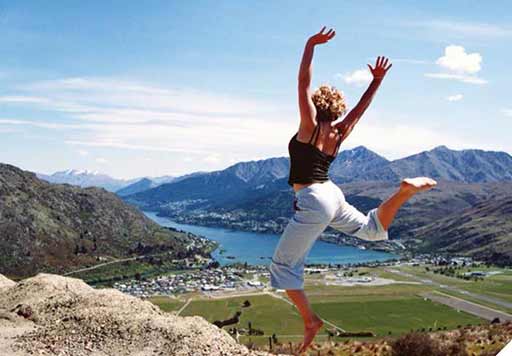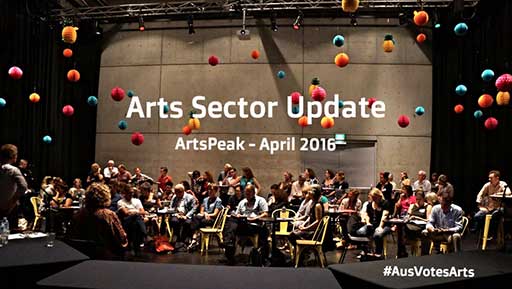Sustainable careers
Ausdance calls for government stimulus to include arts workers

As we are all very aware, the arts and live performance have been devastated by the impact of COVID-19, along with the rest of the community.
Any businesses that practice in the arts sector, be they for-profit or not-for-profit, big, small or individual, must be included in the upcoming economic stimulus package. In the dance sector there are studios, performance companies and individuals who have had their work lost or diminished to the point of closing down. Any government stimulus for business must include arts workers, and take account of issues such as rent and mortgage assistance, freezing of utility bills, and rapid responses by Centrelink, including the abandonment of waiting times.
With so many independent practitioners in dance, we implore all governments to find ways to support individuals and sole traders through this crisis. Artists have always been extremely resourceful in sustaining their practice through normal times. Their opportunities for other work though, have now diminished to the point of non-existence and, despite their many creative resources, the financial and artistic consequences for them are dire.
Eventually the pandemic will pass. We don’t know when. When it does, the creative industries, and especially the arts, will be the leaders in reviving the spirits of the community and working with all Australians to restore society and the economy. Everything possible must be done to ensure that artists are actually around to do so.
If you want to contribute to Ausdance's knowledge of the impact of COVID-19 on your practice, please complete this survey.
For further information contact:
Paul Summers, Ausdance National President
Mobile 0417 925 292
Lewis Major receives Keith Bain Choreographic Travel Fellowship
At the 21st Australian Dance Awards (8 September 2018), Ausdance National awarded the Keith Bain Choreographic Travel Fellowship to Lewis Major. The fellowship provides financial assistance for an emerging choreographer to travel internationally with the sole purpose of developing and extending their choreographic practice.
Executive Director’s May update
We are currently representing the dance sector by contributing knowledge to three urgent issues that impact healthy growth in Australia’s creative economy:
- Access to professional mental health support for those who work in the entertainment industry, because we can't tackle these issues in isolation. We need to support each other.
- Access to education and training resources to prevent discrimination, harassment, sexual harassment and bullying, because these impact our mental health and wellbeing. Together we can create healthy work environments free from these threats.
- Sustainable access to international expertise that transfers skills to Australian organisations and creatives, because this will stimulate innovation.
Have your say! Entertainment Industry Wellbeing Survey
Five Australian entertainment industry professionals attempt suicide every week. The time for change is now!
We need you, as an Australian entertainment industry professional, to share your thoughts surrounding the mental health needs of our industry people, how they should be supported and what are the most pressing issues.
Fatigue identified as major contributor to injury in Australia’s professional dancers
The Safe Dance Report IV: Investigating injuries in Australia’s professional dancers, published today on the Ausdance National website, examines the Australian context and occurrence of injury in professional dancers and makes recommendations to support sustainable, healthy, and productive dancing careers.
A collaboration between The University of Sydney and Ausdance National, Safe Dance IV is the fourth in a series of Safe Dance research projects. It continues the important work started by Ausdance National almost 30 years ago.
The survey of 195 Australian professional dancers found 97% experienced at least one significant injury in their dance career, compared with 89% in 1999. And 73% of dancers reported experiencing a dance-related injury in the past 12 months.
Author and lead researcher Amy Jo Vassallo, a PhD candidate at the Faculty of Health Sciences at The University of Sydney, said the consequences of these injuries can be quite substantial and include missed performance opportunities and income, ongoing pain and disability, and expensive treatment including surgery. Serious injuries can even lead to early retirement from dance careers and lifelong disability.
‘The proportion of dancers reporting fatigue as a contributing factor to their injury has increased from 26% in 1990 and 33% in 1999 to 48% in 2017’ she said.
‘However, compared with previous Safe Dance survey results, fewer dancers reported poor technique or environment as a contributor to their injury. This demonstrates the benefits of education, policies and interventions regarding safe dancing practice for dancers and teachers at all stages of a dance career, including early teaching and pre-professional training’.
Ausdance National President, Professor Gene Moyle, said the Safe Dance Report IV continues an important lineage for the Australian dance community. Hearing the words “safe dance practice” being so much a part of our language and approach within the dance sector today is a testament to the impact and contribution of the collective Safe Dance reports within our industry.
Recommendations have outlined that access to dance-educated or dance-specialised healthcare services is essential; addressing the cultural aspects of injury reporting is critical; and that a better acknowledgement of the psychological and psychosocial aspects of injury is required.
Key findings
Survey respondents’ employment as a dance performer was most commonly with a dance company (66%) or as an independent dance artist (38%).
Injuries remain common in professional dance, with 73% of professional dancers reporting experiencing an injury in the past 12 months. The most common site of injury was the ankle (26%), followed by the knee (11%) and hip (10%).
The most common injury type was a strain (25%), followed by chronic inflammation (19%) and a sprain (18%).
There was one accidental or traumatic injury for every two overuse or gradual injuries. The most common responses regarding the self-reported contributor to injury were fatigue (48%), followed by new or difficult choreography (39%) and ignoring early warning signs (31%).
Despite 62% of respondents reporting belief that there is still stigma associated with sustaining injuries as a professional dancer, 75% of dancers did say they would seek professional opinion if they suspected an injury. However, only 50% stated they would tell someone within their dance employment and 49% said they would also take their own preventative steps to manage their injury.
Despite seeing a clinician for treatment of their injury, 40% of dancers whose injury was currently unresolved were unsure if their injury would resolve in the foreseeable future. This indicates that many dancers need to be provided with improved and realistic expectations of their injury, capacity to dance during their injury and likely return to full dance ability.
For interview contact:
Amy Vassallo | PhD Candidate
Faculty of Health Sciences
The University of Sydney
Email: [email protected]
Phone: 02 9351 9010 and 02 9351 9108
Ausdance National Council – Ausdance Inc.
Email: [email protected]
Download Safe Dance Report IV media release
Kristina Chan receives the Peggy van Praagh Choreographic Fellowship

Congratulations to Kristina Chan who received the Ausdance National Peggy van Praagh Choreographic Fellowship at the 2017 Australian Dance Awards on Sunday 24 September 2017.
National Dance Forum 2017: Dance in the Digital Domain
Tuesday 22 August 2017
For immediate release
Australia’s peak dance organisation, Ausdance National, will host a two-day forum next month bringing together dance makers, producers and presenters for a highly topical forum focusing on the future of dance within the digital domain. The National Dance Forum is Australia’s key platform for dance artists, industry professionals and educators in providing rich opportunities to discuss, debate and collaborate with some of the most influential individuals and organisations in the country.
First National Dance Forum 2017 speakers announced
We know the dance sector wants a chance to share, inspire, connect and to be inspired by the whole dance industry—that includes the broader ecology, from independents to majors. At NDF 2017 we'll hear inspiring talks from our National Dance Forum 2017 speakers.
Here are our first speakers for this year's forum.
Arts education advocates question VET Student Loans methodology
The NAAE supports the review of the VET FEE-HELP rules, and understands the need to weed out those rorting the system and those private providers delivering sub-standard courses in line with Australian Quality Framework (AQF) that applies to all post-compulsory education. However, we have major concerns about the methodology used to identify courses that will no longer qualify for government assistance, and take this opportunity to provide information that may not have been available earlier.
NAAE noted firstly that the department must take account of poorer SES students who may use VET courses as a gateway to university study. If reputable RTOs offering arts courses are eliminated, these opportunities will immediately disadvantage some students, particularly those from regional and remote schools where the arts have been a major factor in eliminating poor attendance records, and where career pathways in the arts are identified.
NAAE also questioned why some previously eliminated providers are already back on the list, and yet the larger reputable TAFEs and arts training institutions are not. NAAE would like to know what criteria were used to make these decisions.
In response to a question about whether there was another sector like the Arts, NAAE noted that the arts industry was unique in the ways in which it trained and employed artists.
Recommendations about the methodology used to define eligible courses
National forum to explore dance practice in the digital age
16 May 2017
The 2017 National Dance Forum will bring together makers, producers and presenters to discuss and share knowledge on current digital practices and technological developments. The two-day forum will focus on strengthening the dance sector’s capacity within the digital domain.
Led by the dance sector’s advocate for 40 years—Ausdance National—the fourth National Dance Forum (NDF2017) will take place at the Victorian College of the Arts in Melbourne, 25–26 September 2017 and will follow the Australian Dance Awards (Arts Centre Melbourne, 24 September 2017).
Dance artists, companies, presenters and researchers looking for ways to grow meaningful audience relationships and understand the issues around making art in a digital environment, need to attend.
Ausdance advocacy report
 Ausdance National's new interim National Executive has formally appointed Ausdance National (volunteer) representatives to attend and speak for Ausdance at the following organisations and forums: ArtsPeak, National Advocates for Arts Education, World Dance Alliance and Tertiary Dance Council of Australia.
Ausdance National's new interim National Executive has formally appointed Ausdance National (volunteer) representatives to attend and speak for Ausdance at the following organisations and forums: ArtsPeak, National Advocates for Arts Education, World Dance Alliance and Tertiary Dance Council of Australia.ArtsPeak update
Ongoing work
As well as recovering from the ArtsPeak National Arts Election Debate six months ago, there has been ongoing work: following up with the Australia Council on the Service Organisations Scan (complete, to be released by the Australia Council in the first quarter of 2017); advocating for the arts courses that will be affected by the VET student loans proposal (ongoing); and continuing to voice the sector’s concerns about the impact of the 2015 budget changes. The Executive has also played a part in Arts Front, and is currently monitoring (with great interest) the new initiative for a Myer, Tim Fairfax Family and Keir Foundations cultural think tank.
LEAP Together Conference report
Toronto, Canada, 11–12 Nov 2016
LEAP Together: Career and Life Transitions in Dance and Sport was one of the key initiatives of a pioneering partnership between Dancer Transition Resource Centre (DTRC) and Canadian Sport Institute Ontario (CSIO), and is funded by the Ontario Trillium Foundation.
The conference included a wide diversity of stakeholders from the sport and dance sectors to learn and exchange knowledge on various topics related to transition for high performers – professional dancers and elite athletes.
Inquiry into innovation and creativity: workforce for the new economy
The Standing Committee on Employment, Education and Training invites you to make a submission to the inquiry into Innovation and Creativity: Workforce for the New Economy
'On Wednesday 9 November 2016 the Committee adopted an inquiry referred by the Minister for Employment, Education and Training, Senator the Hon Simon Birmingham, asking the Committee to inquire into and report on matters that ensure Australia’s tertiary system—including universities and public and private providers of vocational education and training—can meet the needs of a future labour force focused on innovation and creativity.'
Make your submission by addressing the terms of reference by 13 January 2017.
National Indigenous Dance Forum—join the Curatorial and Community working groups
The National Indigenous Dance Forum (NIDF), in partnership with Yirramboi Festival (Melbourne Indigenous Arts Festival), will take place from 5–7 May 2017 in Melbourne.
It's time to get involved! Be part of the NIDF curatorial or community working groups (or join BOTH).
VET funding cuts—impact on professional dance training
VET funding cuts—impact on professional dance training—media release (246 KB PDF)
Senator the Hon. Simon Birmingham
Minister for Education and Training
PC Box 6100, Senate
Parliament House
Canberra ACT 2600
Dear Minister,
Ausdance is deeply concerned about your decision to include some of Australia's leading professional dance training courses in the crackdown on courses eligible for VET student loans.
We are particularly concerned about the statement that these professional dance training courses are being subsidised because they are 'used simply to boost enrolments, or provide 'lifestyle' choices, but don't lead to work'.
Apply for the Caroline Plummer Fellowship in Community Dance 2017
Apply now for the Caroline Plummer Fellowship in Community Dance. Applications close 1 June 2016.

National Arts Sector Meeting
National Arts Sector Meeting
- Where: Arts House, North Melbourne Town Hall , Queensberry St, North Melbourne, Victoria
- When: 12.45 pm – 5.00 pm, 7 June
- Register for the National Arts Sector Meeting (Space is limited, so please book early.)
ArtsPeak Arts Sector Update #1 2016—an invitation to sector meetings and the Election Debate

Welcome! ArtsPeak is producing a series of National Arts Sector Updates in the lead-up to the Federal election in July. This work picks up on last year's Free the Arts updates and is being delivered as part of our partnership with Feral Arts. A National Election Strategy Group is coordinating the work. Membership is open to anyone. If you would like to get involved email [email protected]
Please share this update in your networks and with your members.
New low as Government pumps Catalyst funds out the door in blatant pre-election pork barreling
ArtsPeak Media Release (45 KB PDF)
9 May 2016
The arts sector is reeling today at news that an extraordinary $13m in Catalyst funds were secretly pushed out the door over the weekend just in advance of the election being called and caretaker mode beginning.
In total $23,317,301 has now been spent – nearly half the $48m allocated for the next 4 years of Catalyst operations. When Senate Estimates sat last Thursday evening the committee were only made aware of the $10m of grants announced by Arts Minister Mitch Fifield last week.

